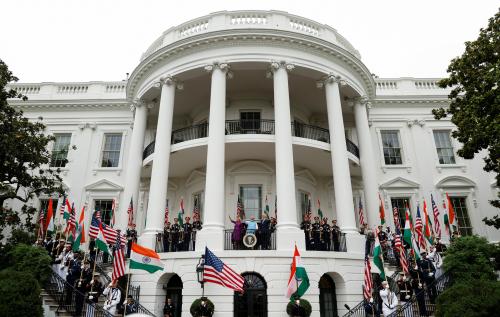As President Barack Obama prepares for his trip to Asia this week, he will face questions not just about the administration’s signature rebalance, or “pivot” toward that region, but also about the crisis in Ukraine. The leaders Obama will meet in South Korea, Japan, Malaysia, and the Philippines will be preoccupied with what appears to them as a potential Asian parallel to the challenge Europe faces: How can the United States and its friends and allies deal with an increasingly assertive regional power? Put more bluntly — as the leaders will surely do in their private talks with Obama — how would the United States respond if China should resort to unilateral territorial intervention in their own backyard?
The administration’s strategic shift to East Asia in 2011 was built on two pillars. First, the United States would pursue its long-term interest in peace and stability in East Asia through sustained commitment to its traditional allies; second, it would build a cooperative, constructive relationship with a rising China, while also managing differences.
In theory, this strategy is intended to take account of the inevitable growth of China’s influence while reducing the danger that the relationship will lead to instability or even conflict. But in recent months, as China has pressed its territorial claims in the East and South China seas, the viability of this strategy has been increasingly put to the test. China’s unilateral acts — including its November declaration of an air defense identification zone in the East China Sea that included the disputed Senkaku Islands administered by Japan (which Beijing claims and calls the Diaoyu) and its efforts to block the resupply of Philippine Marines on the disputed Second Thomas shoal — have frightened China’s neighbors and led to questions of what the rebalance means in the context of these troubling moves.
The Obama administration has repeated its long-standing position that it takes no position on the merits of the sovereignty disputes, but opposes the use of force or coercion to resolve them. And it has asserted that it stands by its treaty commitments to Japan and the Philippines. But that has not led to significant progress. The risk of conflict remains high.
The situation in Asia is arguably more complex than in Ukraine, where the United States has no bilateral security treaty but has clearly stated that Russia has infringed on Ukraine’s sovereignty. Conversely, while the United States has formal treaty obligations in East Asia, it acknowledges that the countries in question differ on territorial sovereignty. And by taking no position it admits to the situation’s ambiguity.
The United States could abandon its neutrality and side with Japan and the Philippines on the territorial disputes, to dissuade Chinese adventurism. But such a move would deepen tensions between the United States and China without necessarily pushing Beijing to engage more diplomatically with its neighbors. And it risks moving toward bilateral confrontation with echoes of the Cold War — a result none of the United States’ partners in the region would welcome, given their deep economic interdependence with China.
Instead, a more comprehensive approach to the changing tectonics of East Asia is needed: one that treats the territorial disputes not as isolated problems, but rather addresses the fundamental problem of dealing with a rising power.
For four decades since then-President Richard Nixon’s historic 1972 trip, the relationship between the United States and China has been largely cooperative. A weak China posed little threat to the United States and its allies while offering a growing market for U.S. goods, a source of inexpensive imports for the U.S. consumer, and a partner in the struggle to contain the USSR.
But with the end of the strategic alignment based on shared concerns about the USSR, coupled with China’s increasing military capacity fueled by its spectacular economic growth, both sides have increasingly questioned the sustainability of that cooperation. Many in China see the U.S. rebalance as ill-disguised containment, while many in the United States see Chinese military modernization and territorial assertiveness as strong indications that Beijing seeks to undermine Washington’s alliances and drive the United States from the Western Pacific. The result threatens to be a familiar albeit tragic one: growing tension leading to conflict that serves no one’s interest. And given China’s huge economic potential and momentum, it is in many ways a more formidable potential adversary than Russia, despite the latter’s huge stock of nuclear weapons.
Chinese President Xi Jinping proposed solving the problem by building strategic trust, and “a new form of major power relationship.” But that begs the most important questions: how to build trust, and what kind of relationship can the United States and China aspire to? Compounding this challenge, the long-term intentions of both sides are inherently unknowable. The inclination in the face of such uncertainty is to prepare for the worst — which all too frequently becomes a self-fulfilling prophecy.
To manage this dilemma, the United States needs a clear strategy. We propose one entitled “Resolve and Reassure.”
War too often results from misplaced judgments about another country’s resolve. In East Asia, and between China and the United States, the Korean War demonstrates what can happen when countries miscalculate other’s willingness to act. The United States needs to project clarity about its resolve to defend its vital interests. And in the current context of East Asia, nowhere is this more important than with respect to alliance commitments. To prevent misjudgment, the United States must sustain the credibility of its treaty obligations, both in words — as the administration has done by making clear that the Senkakus fall under the U.S. obligation to assist Japan via the U.S.-Japan security treaty — and in actions.
That does not mean Washington must immediately unsheathe the sword if tensions escalate over China’s actions near the Senkakus or disputed islands in the South China Sea, but it must make clear that it is prepared to impose significant costs if red lines are crossed — which is why the response to Russia’s actions in Ukraine is so salient to the situation in East Asia.
U.S. allies in Asia worry that China’s ability to impose economic costs against the United States might deter Washington from acting — a concern exacerbated by U.S. and European caution in imposing costs on Russia. The late March expansion of sanctions against Russia should help reassure U.S. allies of Washington’s willingness to accept the risks of economic retaliation in order to impose costs on those who cross red lines. U.S. allies will be watching closely to see if the threats of broader sanctions become more concrete in the event of further Russian encroachments.
But projecting resolve is only one part of a strategy to stabilize U.S.-China relations. The United States and its allies also have an interest in reassuring China that if Beijing acts responsibly, they will not seek to thwart its future prosperity and security. Resolve must be matched by appropriate confidence building, including the willingness to enter into mutual agreements that help make credible each side’s professions of good intentions. These might include “Open Skies” reconnaissance agreements, where both sides allow territorial overflights to reduce concerns about concealment; agreements for handling incidents at sea to reduce the risk of accidental encounters that could be interpreted as deliberate provocations, whether they are or not; and restrictions on destabilizing activities in space, such as the deliberate destruction of spacecraft.
Just as important as formal agreements is the willingness of both sides to exercise restraint in defensive actions that might appear threatening; to enhance transparency to dispel misunderstandings; and to reciprocate positive actions to stimulate a virtuous circle of enhanced confidence. This might mean Chinese willingness to slow the rate of its military buildup rather than race for parity. And for the United States it might mean modifying its Air-Sea Battle concept, beginning with a more benign name such as Air-Sea Operations and a more inclusive approach toward implementation, to emphasize defensive objectives instead of offensive operations — which some Chinese view as seeking the ability to deliver a pre-emptive, knock out blow. Both sides need to revise and coordinate their contingency planning in places like the Korean Peninsula, in order to mitigate the dangers of unwanted escalation.
This is an ambitious agenda. But if China and the United States hope to avoid the growing rivalry that has too often accompanied the interaction between a dominant and rising power, this effort is needed. A judicious combination of strategic reassurance and resolve could save the U.S.-China relationship from the spiral of mistrust that characterizes the U.S.-Russia relationship today — and protect against the even greater dangers that could result.
The opinion originally appeared in Foreign Policy.


Commentary
Op-edDon’t Be a Menace to South (China Sea)
April 21, 2014